|
Report from
Europe
European tropical wood imports up 16% on previous
year
EU imports of tropical timber products increased sharply
between September 2014 and April 2015 but slowed again
in the four months to end September 2015 (Chart 1).
Nevertheless, the value of EU imports of tropical timber
across all product groups in the first 9 months of 2015
was, at €1.703 billion, 16% greater than the same period
the previous year. So far EU imports of tropical timber in
2015 have been close to levels last seen in 2012.

EU imports of all tropical wood products have increased
this year. With the exception of plywood (+8.6%), veneers
(+7.5%) and í░otherí▒ (+4.3%), all tropical product groups
showed double-digit import growth. Mouldings (+36.4%)
and joinery (+28.2%) experienced the highest growth
rates.
Imports of sawnwood, the most important tropical product
group in terms of import value, rose by 14.2% to €565.1
million. Imports of tropical logs (+24.1%) have also
continued their upward trend this year after several years
of steep decline (Chart 2).
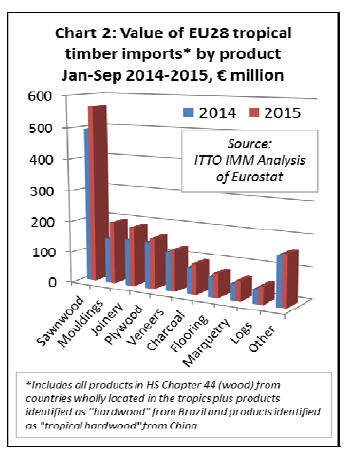
Some of the increase in the euro value of tropical wood
imports is due to the relative weakness of the European
currency this year which has led to price inflation for
European importers.
However, this has been partly offset by producers
lowering their sales prices and by a steep fall in freight
rates as the year progressed.
Further analysis of the data also shows that the quantity of
EU tropical wood imports has increased across nearly all
product groups.
Increased imports into all major EU markets
A closer look at the individual EU countries reveals that
tropical timber deliveries to all important markets have
increased this year, in most instances by a significant
margin. Spain (+7.9% to €76.2 million) and Italy (+3.1%
to €144.4 million) were the only major markets to show
single-figure growth rates (Chart 3).
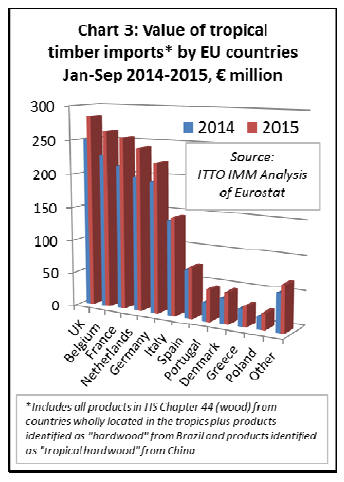
The UK has remained the most important tropical timber
market in Europe this year, with growth of 13.7% in
imports to €285.1 million across all product groups during
the first nine months. There was also substantial growth in
imports into Belgium (+15.6% to €263.9 million), France
(+19.4% to €255.1 million), and the Netherlands (+21.3%
to €241.9 million).
Deliveries of tropical wood to the German market
increased 13.8% to €221.1 million in the first nine months
of 2015. However, reports from German importers are
slightly less positive.
While some importers specialising in African timber
report satisfactory business this year, those focused on
Asian timber describe the market as difficult. The same is
true for tropical plywood from South-East Asia, which is
under intense competitive pressure from European and
Russian poplar and birch products.
The German timber trade federation GD Holz reports that
wood product sales in Germany have more or less
stagnated in the first nine months of this year. Moreover,
garden wood assortments, including decking, experienced
decline by around 5%.
The same is true for sawn timber. For building products
and joinery, on the other hand, GD Holz reports growth of
around 5%.
Sharp increase in EU sawn imports from Malaysia and
Brazil
EU imports of tropical sawn timber increased by 9% to
793,100 m3 in the first nine months of 2015. Imports from
Cameroon, the largest supplier, increased 7% to 233,000
m3. Import growth was even more rapid from Malaysia
(+22% to 173,800m3), Brazil (+21% to 99,500m3), and
the Democratic Republic of the Congo (+14% to
21,000m3).
Imports from Gabon (+1% to 70,400m3) and Congo (+6%
to 38,500m3) recorded below-average growth rates.
Meanwhile, imports from Ghana (-15% to 19,100m3) and
Ivory Coast (-5% to 62,200m3) have declined this year
(Chart 4).
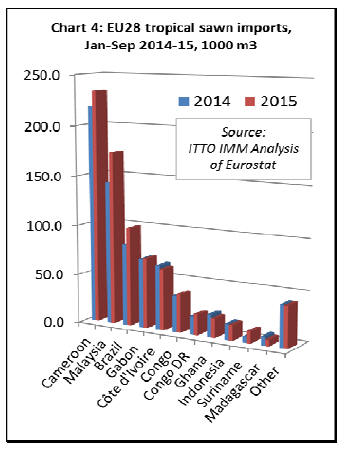
Market recovery in Benelux and France
The rise in tropical sawn wood deliveries to Europe was
primarily due to higher imports into the Netherlands
(+25% to 176,100m3), Belgium (+14% to 213,300m3)
and, to a lesser extent, France (+6% to 101,400m3).
By contrast, imports into the UK, which increased sharply
in 2014, declined 22% to 58,100m3 in the first nine
months of 2015. Tropical sawn wood imports into
Germany (-5% to 44,400m3) and Italy (-2% to 92,000m3)
have also declined this year (Chart 5).
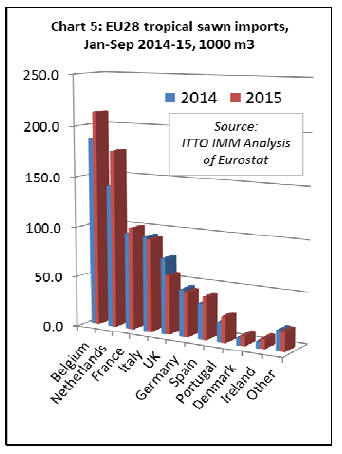
In their latest statistical report (covering the first 8 months
of 2015) the UK Timber Trade Federation (TTF) reports
í░all regions of the world except Central and South
America have exported less to the UK in 2015 to date.
Only a tripling of volumes from Guyana (from a relatively
low base) has provided regional growth in 2015í▒.
Hardwood deliveries to the UK from Asia declined 17%
while imports from Africa were down 28% in the first 8
months of 2015. Despite the sharp uptick in imports from
Guyana, UK hardwood imports from South and Central
America were no more than 8,000m3 in the first 8 months
of 2015.
Tropical log imports up 24%
Following nearly a decade of continuous decline, EU
imports of tropical logs have recovered a little ground this
year. Imports increased 24% to 127,338m3 in the first nine
months of 2015. Much of this import growth was
concentrated in the first five months and the pace of
imports slowed between June and September.
EU tropical log imports from Cameroon doubled to
30,464m3 and deliveries from the Central African
Republic almost tripled to 14,122m3 in the first nine
months of 2015. Imports from Suriname also tripled from
a low base to 2,776m3. However imports from Liberia
declined 33% to 4,570m3 (Chart 6).
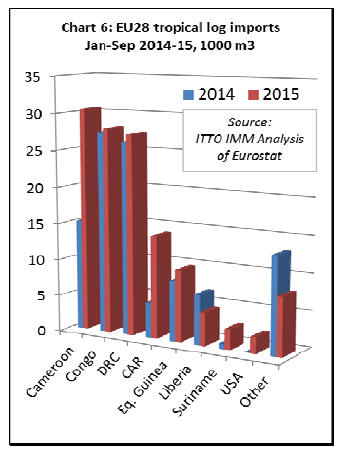
Rising EU decking imports from Indonesia, Brazil and
Malaysia
EU imports of tropical mouldings (which includes both
interior mouldings and exterior decking products) were
171,218 m3 in the first nine months of 2015, 12% more
than the same period in 2014.
Imports increased from all the major supply countries
including Indonesia (+10% to 74,059m3), Brazil (+24% to
60,672m3) and Malaysia (+10% to 14,307m3). Deliveries
from several other countries, including Peru, Bolivia and
Gabon, also increased from a low base. However imports
from Ivory Coast were much lower than last year (Chart
7).
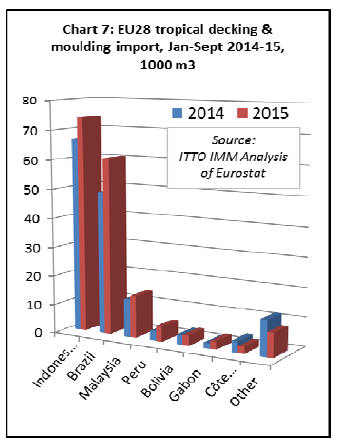
Forecast for slow economic recovery
The EU continues to recover only gradually from the
financial and economic crisis. The European
Commissioní»s Autumn Economic forecast, published on 5
November, notes that the economic recovery in the EU is
now in its third year and that í░it should continue at a
modest pace next year despite more challenging conditions
in the global economyí▒.
The European economy continues to benefit from low oil
prices, accommodative monetary policy and the relatively
weak external value of the euro, which is helping boost
competitiveness, according to the EC.
Looking forward, the EC forecasts GDP growth to rise
from 1.9% this year to 2.0% in 2016 and 2.1% in 2017. In
making this assessment, the EC comments that í░the impact
of the positive factors is fading, while new challenges are
appearing, such as the slowdown in emerging market
economies and global trade, and persisting geopolitical
tensions.
Backed by other factors, such as better employment
performance supporting real disposable income, easier
credit conditions, progress in financial deleveraging and
higher investment, the pace of growth is expected to resist
the challenges in 2016 and 2017. In some countries, the
positive impact of structural reforms will also contribute to
supporting growth furtherí▒.
Recent reports from IFU, an economic research institute
based in Germany, are slightly less optimistic. IFUí»s index
of the economic climate in the euro area dropped by two
percentage points in the fourth quarter of 2015. IFU note
that í░while assessments of the current economic situation
brightened slightly, the six-month economic outlook
continued to cloud over. The euro area economy continued
its recovery at a subdued paceí▒.
Regarding the current economic situation, experts
surveyed by IFO in Greece, Finland, France, Italy, Spain,
Austria, Portugal, and Cyprus continued to assess the
situation negatively. In most other euro countries the
situation was described as satisfactory. IFUí»s six-month
economic outlook remains positive overall but was scaled
back in several countries, especially in France, Spain and
Portugal.
|